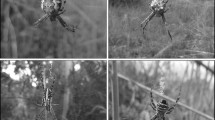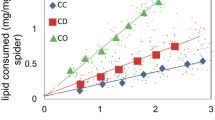Abstract
Orb web spiders of the genus Argiope are permanently located at the hub of the orb web and are thus vulnerable to changing environmental conditions. Severe damage to the web by non-prey animals can have a significant impact on survival, through the cost of producing expensive silk and the loss of foraging opportunities. Thus, selection should favor web protection mechanisms, and the conspicuous web decorations, typical of Argiope spiders, may play a role. Decorated webs suffer less damage than undecorated webs, consistent with the view that they advertise the presence of the web to non-prey animals that may damage the web. However, whether spiders respond to web damage by increasing investment in web decorations has not been investigated. We subjected adult St. Andrew's Cross spider (Argiope keyserlingi) females to three levels of web damage and recorded their subsequent web-decorating behavior. Mild damage, similar to that caused by impacting prey, did not affect either web building or decorating behavior. However, spiders subjected to substantial web damage both reduced the size of subsequent webs and increased investment in web decoration size. These data are consistent with an advertising role of web decorations.



Similar content being viewed by others
References
Baba Y, Miyashita T (2006) Does individual internal state affect the presence of a barrier web in Argiope bruennichi (Araneae: Araneidae)? J Ethol 24:75–78
Blackledge TA (1998) Signal conflict in spider webs driven by predators and prey. Proc R Soc Lond B 265:1991–1996
Blackledge TA, Wenzel JW (1999) Do stabilimenta in orb webs attract prey or defend spiders? Behav Ecol 10:372–376
Blackledge TA, Wenzel JW (2001) Silk mediated defense by an orb web spider against predatory mud-dauber wasps. Behaviour 138:155–171
Bruce MJ (2006) Silk decorations: controversy and consensus. J Zool 269:89–97
Bruce MJ, Herberstein ME, Elgar MA (2001) Signalling conflict between prey and predator attraction. J Evol Biol 14:786–794
Bruce MJ, Heiling AM, Herberstein ME (2005) Spider signals: are web decorations visible to birds and bees? Biol Lett 1:299–302
Cheng R-C, Yang E-C, Lin C-P, Herberstein ME, Tso I-M (2010) Insect form vision as one potential shaping force of spider web decoration design. J Exp Biol 213:759–768
Chmiel K, Herberstein ME, Elgar MA (2000) Web damage and feeding experience influence web site tenacity in the orb web spider Argiope keyserlingi Karsch. Anim Behav 60:821–826
Craig CL (2003) Spiderwebs and silk: tracing evolution from molecules to genes to phenotypes. Oxford University Press, Oxford
Craig CL, Bernard GD (1990) Insect attraction to ultraviolet reflecting spider webs and web decorations. Ecology 71:616–623
Craig CL, Wolf SG, Davis LD, Hauber ME, Maas JL (2001) Signal polymorphism in the web-decorating spider Argiope argentata is correlated with reduced survivorship and the presence of stingless bees, its primary prey. Evolution 55:986–993
Eberhard WG (2003) Substitution of silk stabilimenta for egg sacs by Allocyclosa bifurca (Araneae: Araneidae) suggests that silk stabilimenta function as camouflage devices. Behaviour 140:847–868
Eberhard WG (2007) Stabilimenta of Philoponella vicina (Araneae: Uloboridae) and Gasteracantha cancriformis (Araneae: Araneidae): evidence against a prey attractant function. Biotropica 39:216–220
Edmunds J (1986) The stabilimenta of Argiope flavipalpis and Argiope trifasciata in West Africa, with a discussion of the function of stabilimenta. In: Eberhard WG, Lubin YD, Robinson BC (eds) Proc. 9th Int. Congr. Arachnol., Panama 1983. Smithsonian Institution Press, Washington, DC, pp 61–72
Eisner T, Nowicki S (1983) Spider web protection through visual advertisement: role of the stabilimentum. Science 219:185–187
Enders F (1974) Vertical stratification in orb-web spiders (Araneidae, Araneae) and a consideration of other methods of coexistence. Ecology 55:317–328
Foelix RF (1996) Biology of spiders. Oxford University Press & Georg Thieme Verlag, New York, Oxford
Hansell M (2005) Animal Architecture. Oxford University Press, Oxford
Hauber ME (1998) Web decorations and alternative foraging tactics of the spider Argiope appensa. Ethol Ecol Evol 10:47–54
Herberstein ME (2000) Foraging behaviour in orb-web spiders (Araneidae): do web decorations increase prey capture success in Argiope keyserlingi Karsch, 1878? Aust J Zool 48:217–223
Herberstein ME, Tso I-M (2000) Evaluation of formulae to estimate the capture area and mesh height of orb webs (Araneoidea, Araneae). J Arachnol 28:180–184
Herberstein ME, Craig CL, Coddington JA, Elgar MA (2000a) The functional significance of silk decorations of orb-web spiders: a critical review of the empirical evidence. Biol Rev 75:649–669
Herberstein ME, Craig CL, Elgar MA (2000b) Foraging strategies and feeding regimes: web and decoration investment in Argiope keyserlingi Karsch (Araneae: Araneidae). Evol Ecol Res 2:69–80
Higgins LE (1990) Variation in foraging investment during the intermolt interval and before egg-laying in the spider Nephila clavipes (Araneae: Araneidae). J Insect Behav 3:773–783
Horton CC (1980) A defensive function for the stabilimentum of two orb-weaving spiders (Araneae, Araneidae). Psyche 87:13–20
Jaffé R, Eberhard W, De Angelo C, Eusse D, Gutierrez A, Quijas S, Rodríguez A, Rodríguez M (2005) Caution webs in the way! Possible functions of silk stabilimenta in Gasteracantha cancriformis (Araneae: Araneidae). J Arachnol 34:448–455
Kerr AM (1993) Low frequency of stabilimenta in orb webs of Argiope appensa (Araneae: Araneidae) from Guam: an indirect effect of an introduced avian predator? Pac Sci 47:328–337
Levi HW (1968) The spider genera Gea and Argiope in America (Araneae: Araneidae). Bull Mus Comp Zool Harv 136:319–352
Li D, Lim MLM, Seah WK, Tay SL (2004) Prey attraction as a possible function of discoid stabilimenta of juvenile orb-spinning spiders. Anim Behav 68:629–635
Lubin YD, Ellner S, Kotzman M (1993) Web relocation and habitat selection in desert widow spider. Ecology 74:1915–1928
McCook HC (1889) American spiders and their spinning work. Academy of Natural Sciences, Philadelphia
Meyer-Rochow VB (2007) Glowworms: a review of Arachnocampa spp. and kin. Luminescence 22:251–265
Nakata K (2009) To be or not to be conspicuous: the effects of prey availability and predator risk on spider's web decoration building. Anim Behav 78:1255–1260
Nakata K (2010) Attention focusing in a sit-and-wait forager: a spider controls its prey-detection ability in different web sectors by adjusting thread tension. Proc R Soc Lond B 277:29–33
Nentwig W, Heimer S (1987) Ecological aspects of spider webs. In: Nentwig W (ed) Ecophysiology of spiders. Springer, Berlin, Heidelberg, New York, pp 211–225
Olive CW (1982) Behavioral response of a sit-and-wait predator to spatial variation in foraging gain. Ecology 63:912–920
Pasquet A, Cardot J, Leborgne R (2007) Wasp attacks and spider defence in the orb weaving species Zygiella x-notata. J Insect Behav 20:553–564
Rao D, Cheng K, Herberstein ME (2007) A natural history of web decorations in the St Andrew's Cross spider (Argiope keyserlingi). Aust J Zool 55:9–14
Robinson MH, Robinson B (1973) The stabilimenta of Nephila clavipes and the origins of stabilimentum-building in araneids. Psyche 80:277–288
Scharf I, Ovadia O (2006) Factors influencing site abandonment and site selection in a sit-and-wait predator: a review of pit-building antlion larvae. J Insect Behav 19:197–218
Scharff N, Coddington JA (1997) A phylogenetic analysis of the orb-weaving spider family Araneidae (Arachnida, Araneae). Zool J Linn Soc 120:355–434
Schoener TW, Spiller DA (1992) Stabilimenta characteristics of the spider Argiope argentata on small islands: support of the predator-defense hypothesis. Behav Ecol Sociobiol 31:309–318
Seah WK, Li D (2002) Stabilimentum variations in Argiope versicolor (Araneae: Araneidae) from Singapore. J Zool Lond 258:531–540
Starks PT (2002) The adaptive significance of stabilimenta in orb-webs: a hierarchical approach. Ann Zool Fenn 39:307–315
Stephens DW, Brown JS, Ydenberg RC (2007) Foraging: behavior and ecology. University of Chicago Press, Chicago
Thirunavukarasu P, Nicolson M, Elgar MA (1996) Leaf selection by the leaf - curling spider Phonognatha graeffei Keyserling (Araneoidea: Araneae). Bull Br Arachnological Soc 10:187–189
Tso I-M (1996) Stabilimentum of the garden spider Argiope trifasciata: a possible prey attractant. Anim Behav 52:183–191
Tso I-M (1998) Isolated spider web stabilimentum attracts insects. Behaviour 135:311–319
Tso I-M (1999) Behavioral response of Argiope trifasciata to recent foraging gain: a manipulative study. Am Nat 141:238–246
Tso I-M, Chiang S-Y, Blackledge TA (2007) Does the giant wood spider Nephila pilipes respond to prey variation by altering web or silk properties? Ethology 113:324–333
Tusculescu R, Topoff H, Walfe S (1975) Mechanisms of pit construction by antlion larvae. Ann Entomol Soc Am 68:719–720
Vollrath F, Knight DP (2001) Liquid crystalline spinning of spider silk. Nature 410:541–548
Vollrath F, Köhler T (1996) Mechanics of silk produced by loaded spiders. Proc R Soc Lond B 263:387–391
Walter A, Elgar MA, Bliss P, Moritz RFA (2008) Moulting interferes with web decorating behaviour in Argiope keyserlingi (Araneae: Araneidae). J Arachnol 36:538–544
Acknowledgments
We thank Mariella Herberstein for her help in collecting spiders, Todd Blackledge and an anonymous referee for their helpful comments, and DFG for the financial support (to AW).
Author information
Authors and Affiliations
Corresponding author
Additional information
Communicated by J. Choe
Rights and permissions
About this article
Cite this article
Walter, A., Elgar, M.A. Signals for damage control: web decorations in Argiope keyserlingi (Araneae: Araneidae). Behav Ecol Sociobiol 65, 1909–1915 (2011). https://doi.org/10.1007/s00265-011-1200-8
Received:
Revised:
Accepted:
Published:
Issue Date:
DOI: https://doi.org/10.1007/s00265-011-1200-8




